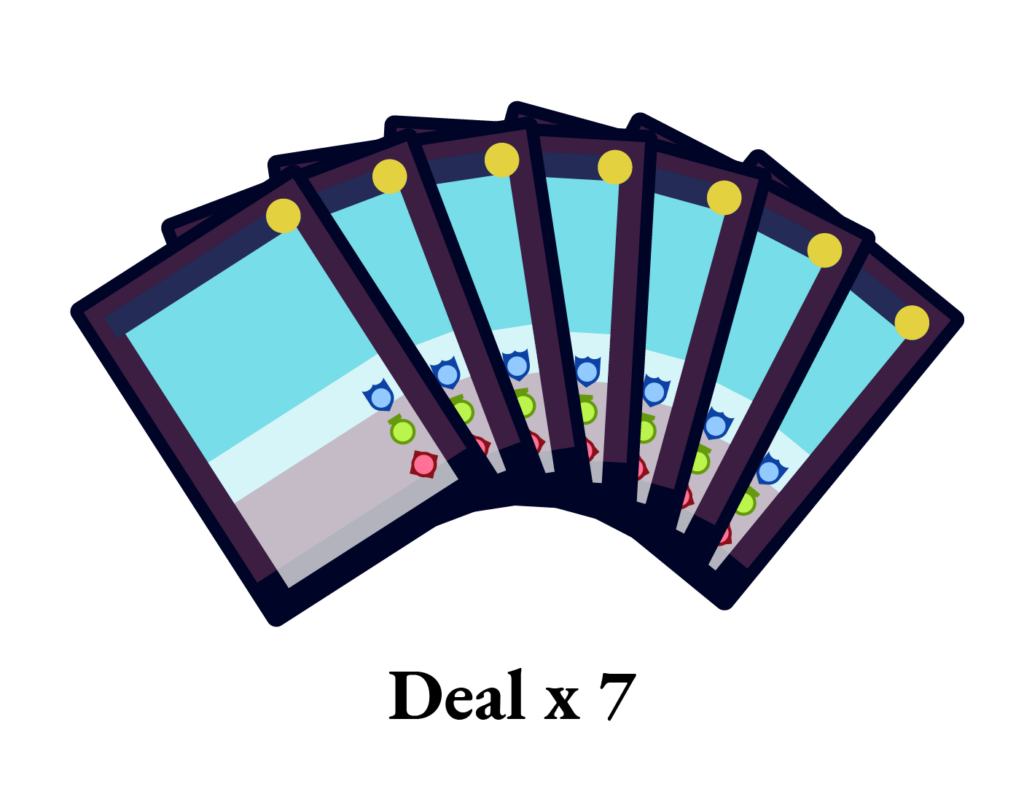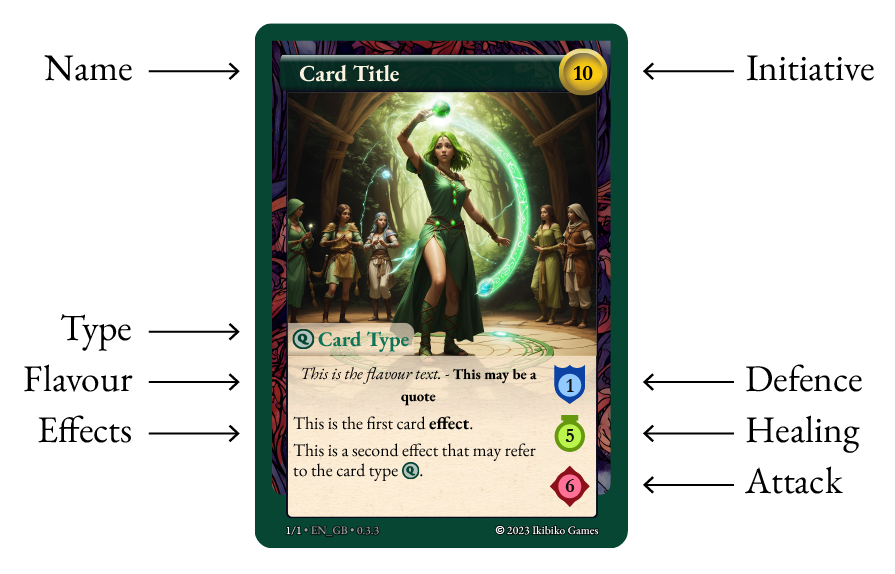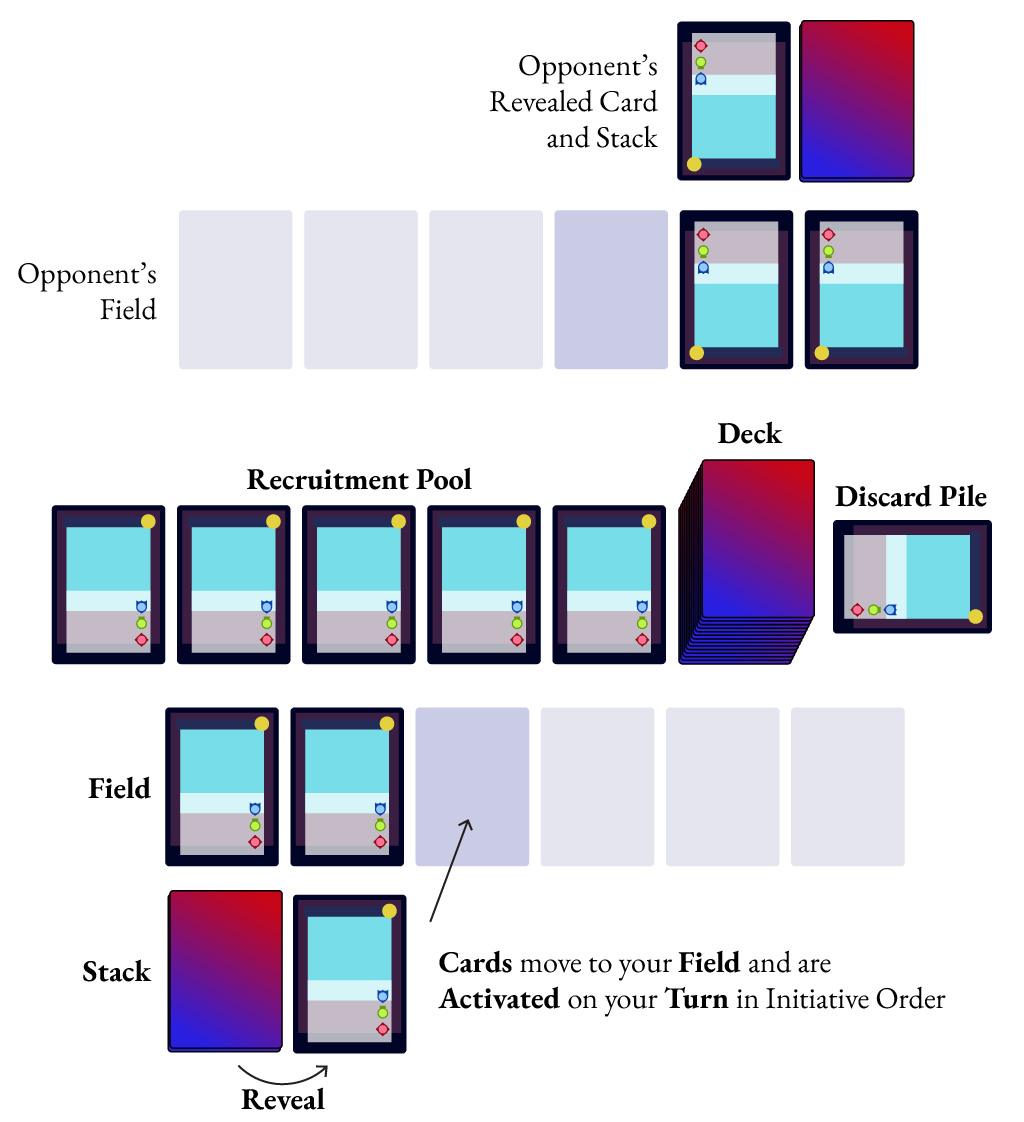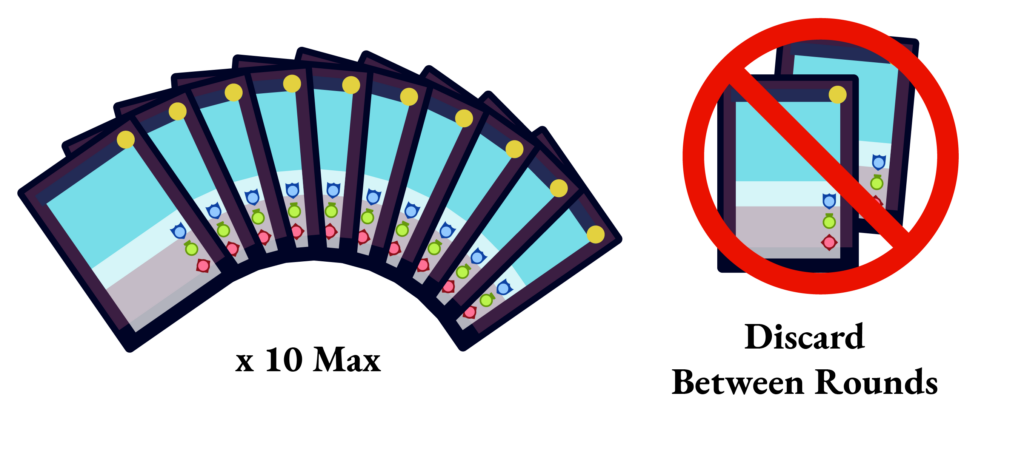Rules version 1.0.0.
Overview
Quaeleon’s Quest is a strategy card game in a fantasy setting for 2 to 6 players, lasting 20-40 minutes, suitable for ages 14 and up.

Your aim is to defeat your opponents by depleting their health in a chaotic battle. Players build stacks of 5 cards, which then play out in initiative order.
The last person standing is the winner. If a player knocks themselves out at the same time as defeating their opponent, there is no winner – you both lose.
In 3+ player games, when you drop to 0 health you are out, and your opponents play on to decide who is the ultimate winner.
Getting Started

Each player starts with 50 health. You can track your health using the cards provided, our free health tracking app, or using a pen and paper. Your health can go above 50, there is no maximum health limit.
Shuffle the deck and deal 7 cards to each player, face down, to form that player’s hand. Everyone can now look at their cards.
Now deal 5 cards face up in the centre of the play area to form the recruitment pool.
How to Use the Health Tracker Cards
Give each person two health tracking cards – a tens digit card and a ones digit card.
The tens digit card has the numbers 0, 10, 20, 30 etc, arranged around each edge of the card. The ones digit card has the digits 0-9 arranged on the right hand side.
Lay the tens digit card on top of the ones digit card, so that the number on the tens digit card lines up with the number on the ones digit card. Add the two numbers together to track your current health (e.g. 50+0 = 50, 20+5 = 25).
Move and rotate the tens digit card to track your current health throughout the game.
You can use a paper clip to more securely hold the cards together, and highlight the current ones digit, especially if you are playing somewhere without a flat table, or the cards a likely to get knocked or blown around.
Anatomy of a Card

Special Terms

| Word | Definition |
|---|---|
| Hand | These are the cards which are not yet in play. Choose from these to build your stack. A maximum of 10 cards should be in any player’s hand at the start of each round. |
| Stack | Your prepared cards for the round (face down). |
| Field | All cards that have been turned and activated. Each player has their own field, and all together are referred to as the field. |
| Reveal | One card is turned from the top of each player’s stack, simultaneously. These cards are not on the field until their initiative order is reached and the card has been fully activated. |
| Activate | When a revealed card’s initiative order is reached its effects and stats are actioned. It is then put on the field at the end of the player’s turn. |
| Resolve | When effects, defence, healing and/or attack are actioned. Some effects may resolve several times. |
| Turn | A player’s turn comes in initiative order allowing them to activate cards or resolve effects. |
| Cycle | The collection of turns between each reveal. |
| Round | A series of cycles that lasts until all players’ stacks are depleted. |
| Recruit | Pick a card from the recruitment pool and add it to your hand. |
| Discard | Choose cards from your hand to send to the discard pile, face up. The discard pile can be searched by any player at any time. |
Rules
Play proceeds in rounds. Each stack you build will last 1 round. A round consists of a number of cycles, made up of turns. Each player will take one turn in each cycle, although there may be effects which take place on other players’ turns.
Play continues until your health, or an opponent’s health, drops down to 0. When this happens, that player must discard all their cards (including your hand, stack, revealed card and field). The winner is the last player left with health remaining.
If at any point there are no cards to draw from on the deck, shuffle the discard pile to form a new deck.
Round 0 – The Initial Swap (optional rule)
If this is your first game, you can skip this step.
Before the first round, players may swap any number of cards they have been dealt and draw the same number of new cards from the deck.
Place discarded cards face down in front of you. Draw the same number of cards from the deck. Once every player has completed this step, turn all the rejected cards face up so every player can see, then shuffle the discarded cards into the deck and proceed to build your decks for round 1. This initial swap may only happen once, at the beginning of a game.
Rounds
Preparation Phase
At the same time, all players choose up to 5 cards from their hand to play this round.
Arrange the cards to form a face down stack, in the order they should be played, from top to bottom. When you are ready, place your stack in front of you. Once you have placed your stack down, you may not look at or alter it.
If you wish, when you have placed your stack, you can announce “For Quaeleon!” to alert your opponents that you are ready.
The Reveal
Every player then simultaneously turns the top card of their stack face up, revealing the card. At this point, announce your initiative out loud.
At the start of your turn, your revealed card enters your field and occupies the leftmost empty space. Each player takes a turn in initiative order, highest to lowest, with ties going to the player with the highest health.
If there is still a tie for initiative, the cards mutually annihilate. Discard all tied cards, and continue play.
Activate a card in the following order:
- Effects
- Defence
- Healing
- Attack
Play then proceeds to the player with the next highest initiative.
If you have no cards left on your stack, you still get a turn, but your initiative is 0. You may have ongoing, or recurring effects, which still take place on your turn.
Play Area

1. Effects
The effects of a card are the first things to apply on the player’s turn. The effects resolve in the order on the card. Any ongoing effects end when a card is sent to the discard pile.
If multiple effects trigger or resolve at the same time, you should resolve them in the order that the cards were activated.
Recruiting
When an effect allows you to recruit cards, you may choose a card from the recruitment pool and add it to your hand. Replenish the recruitment pool immediately with a card from the top of the deck.
If an effect lets you recruit more than 1 card, repeat this process.
2. Defence 
Defence reduces any damage taken from attacks and lasts for the whole round unless the card is removed from the player’s field. To calculate your total defence, you add together the defence from each of the face up cards in your field, including any modifiers from effects of other cards.
Defence also reduces attacks against yourself, or damage from attacks redirected towards yourself, unless an effect says otherwise. If a card says lose x health this bypasses defence.
3. Healing 
Add the amount of healing given by the card to your health value.
4. Attack 
An attack targets all opponents, unless the card explicitly says otherwise.
An attack value must be greater than an opponent’s defence total to deplete that player’s health.
An attack of 0 strength, e.g. one that has been reduced to 0 by an effect rather than defence, is not considered an attack.
If you have multiple cards that attack on your turn, or a card deals multiple attacks, these are separate attacks for the purposes of modifiers and defence.
End of the round

The round ends when all stacks have been depleted and revealed cards resolved, or a card effects triggers the round ending.
When the round ends, all cards on the field and remaining cards on players’ stacks are discarded simulataneously.
Any effect that triggers on discard does not get triggered, as that card is also being discarded.
The person who took the last turn (i.e. activated their card last) should deal 5 new cards to each player.
Each player must then discard cards until their hand contains no more than 10 cards to carry over into the next round.
Players begin the next round by building a new stack.
Clarifications and Other Rules
Up to 5 cards
Remember, you can choose up to 5 cards to form your stack – you do not need to choose 5 every time, you can choose 0 or any number from 1 to 5.
Who Deals
Between rounds, or whenever cards have to be dealt out at random, the person who took their turn last should deal the cards.
There are certain opportunities to “stack” the top of the deck (someone gets to choose the card order), so it may or may not benefit you if you’re the one who has done so.
Negatives
None of the stats can drop below 0, from effects or otherwise. You cannot do negative healing, defence or attack, and you cannot have a negative initiative.
Rounding
When doing any maths, the final result should always be rounded up. Calculate the impact of all effects and then round up, if required.
“The” vs. “Your”
Some cards specify the field, the next card, or the next attack; this does not necessarily mean your next card, or your next attack – beware!
Impossible Requirements
If a card tells you to do something which you, or another player, does not have the means or resources to do, the rest of the effects on the card still apply, unless the effect is conditional. A conditional effect will say something like “Discard 1 card. If you do, pick up 2 cards.”
For example, if an effect tells you to discard a card and then pick up a card, but you have no cards in your hand, you do not have to discard a card and you should still pick up a card to resolve the effect.
Effect Order
Effects happen in activated order. If you have 2 cards on your field, one that adds attack, and one that doubles attack, the operations are performed in the order they were activated.
Worked Example
On your first turn you play a Deal With A Devil card that states:
“All attacks are doubled (including your opponents).”
On your second turn, you play a Galban’s Strength card that states:
“Your next attack does +5 extra damage.”
On your third turn you play a White Dragon. This card does a base 10 attack and has the following effect:
“Half of this card’s total attack, including modifiers, is reflected back to you, ignoring your defence.”
The card’s attack is raised in the following way – first, the attack is doubled (Deal With A Devil resolves).
10 x 2 = 20Then, add 5 (Galban’s Strength resolves).
20 + 5 = 25The card’s attack is now 25, and half the damage is reflected back to you:
25 / 2 = 12.5 rounded up = 13So you would lose 13 health.
This also applies to cards that are triggered by another card – the effects resolve in the order the cards were activated.
